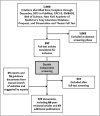Executive summary for the Micronutrient Powders Consultation: Lessons Learned for Operational Guidance
- PMID: 28960876
- PMCID: PMC5656884
- DOI: 10.1111/mcn.12493
Executive summary for the Micronutrient Powders Consultation: Lessons Learned for Operational Guidance
Abstract
Iron deficiency anaemia is estimated to be the leading cause of years lived with disability among children. Young children's diets are often inadequate in iron and other micronutrients, and provision of essential vitamin and minerals has long been recommended. With the limited programmatic success of iron drop/syrup interventions, interest in micronutrient powders (MNP) has increased. MNP are a mixture of vitamins and minerals, enclosed in single-dose sachets, which are stirred into a child's portion of food immediately before consumption. MNP are an efficacious intervention for reducing iron deficiency anaemia and filling important nutrient gaps in children 6-23 months of age. As of 2014, 50 countries have implemented MNP programmes including 9 at a national level. This paper provides an overview of a 3-paper series, based on findings from the "Micronutrient Powders Consultation: Lessons Learned for Operational Guidance" held by the USAID-funded Strengthening Partnerships, Results, and Innovations in Nutrition Globally (SPRING) Project. The objectives of the Consultation were to identify and summarize the most recent MNP programme experiences and lessons learned for operationalizing MNP for young children and prioritize an implementation research agenda. The Consultation was composed of 3 working groups that used the following methods: deliberations among 49 MNP programme implementers and experts, a review of published and grey literature, questionnaires, and key informant interviews, described in this overview. The following articles summarize findings in 3 broad programme areas: planning, implementation, and continual programme improvement. The papers also outline priorities for implementation research to inform improved operationalization of MNP.
Keywords: complementary feeding; evidence-based practice; infant and child nutrition; iron deficiency anaemia; micronutrients; programming.
© 2017 The Authors. Maternal and Child Nutrition Published by John Wiley & Sons, Ltd.
Conflict of interest statement
The authors declare no conflicts of interest.
Figures


Similar articles
-
Experiences and lessons learned for planning and supply of micronutrient powders interventions.Matern Child Nutr. 2017 Sep;13 Suppl 1(Suppl 1):e12494. doi: 10.1111/mcn.12494. Matern Child Nutr. 2017. PMID: 28960875 Free PMC article.
-
Experiences and lessons learned for delivery of micronutrient powders interventions.Matern Child Nutr. 2017 Sep;13 Suppl 1(Suppl 1):e12495. doi: 10.1111/mcn.12495. Matern Child Nutr. 2017. PMID: 28960878 Free PMC article.
-
Experiences and lessons learned for programme improvement of micronutrient powders interventions.Matern Child Nutr. 2017 Sep;13 Suppl 1(Suppl 1):e12496. doi: 10.1111/mcn.12496. Matern Child Nutr. 2017. PMID: 28960877 Free PMC article.
-
Home fortification of foods with multiple micronutrient powders for health and nutrition in children under two years of age (Review).Evid Based Child Health. 2013 Jan;8(1):112-201. doi: 10.1002/ebch.1895. Evid Based Child Health. 2013. PMID: 23878126 Review.
-
Home fortification of foods with multiple micronutrient powders for health and nutrition in children under two years of age.Cochrane Database Syst Rev. 2020 Feb 28;2(2):CD008959. doi: 10.1002/14651858.CD008959.pub3. Cochrane Database Syst Rev. 2020. PMID: 32107773 Free PMC article.
Cited by
-
Designing an ethnographic interview for evaluation of micronutrient powder trial: Challenges and opportunities for implementation science.Matern Child Nutr. 2019 Oct;15(S5):e12804. doi: 10.1111/mcn.12804. Matern Child Nutr. 2019. PMID: 31622039 Free PMC article. Review.
-
Experiences and lessons learned for planning and supply of micronutrient powders interventions.Matern Child Nutr. 2017 Sep;13 Suppl 1(Suppl 1):e12494. doi: 10.1111/mcn.12494. Matern Child Nutr. 2017. PMID: 28960875 Free PMC article.
-
Changes in growth, anaemia, and iron deficiency among children aged 6-23 months in two districts in Nepal that were part of the post-pilot scale-up of an integrated infant and young child feeding and micronutrient powder intervention.Matern Child Nutr. 2019 Apr;15(2):e12693. doi: 10.1111/mcn.12693. Epub 2018 Oct 12. Matern Child Nutr. 2019. PMID: 30226293 Free PMC article.
-
Integrating nutrition services into health care systems platforms: Where are we and where do we go from here.Matern Child Nutr. 2019 Jan;15 Suppl 1(Suppl 1):e12743. doi: 10.1111/mcn.12743. Matern Child Nutr. 2019. PMID: 30748115 Free PMC article.
-
Infant and Young Child Feeding (IYCF) Practices Improved in 2 Districts in Nepal during the Scale-Up of an Integrated IYCF and Micronutrient Powder Program.Curr Dev Nutr. 2018 Apr 25;2(6):nzy019. doi: 10.1093/cdn/nzy019. eCollection 2018 Jun. Curr Dev Nutr. 2018. PMID: 29984348 Free PMC article. Review.
References
-
- Afsana, K. , Haque, M. R. , Sobhan, S. , & Shahin, S. A. (2014). BRAC's experience in scaling‐up MNP in Bangladesh. Asia Pacific Journal of Clinical Nutrition, 23(3), 377–384. - PubMed
-
- Bhutta, Z. A. , Ahmed, T. , Black, R. E. , Cousens, S. , Dewey, K. G. , Giugliani, E. , … Shekar, M. (2008). What works? Interventions for maternal and child undernutrition and survival. The Lancet, 371(9610), 417–440. - PubMed
Publication types
MeSH terms
Substances
LinkOut - more resources
Full Text Sources
Other Literature Sources
Medical
Research Materials

